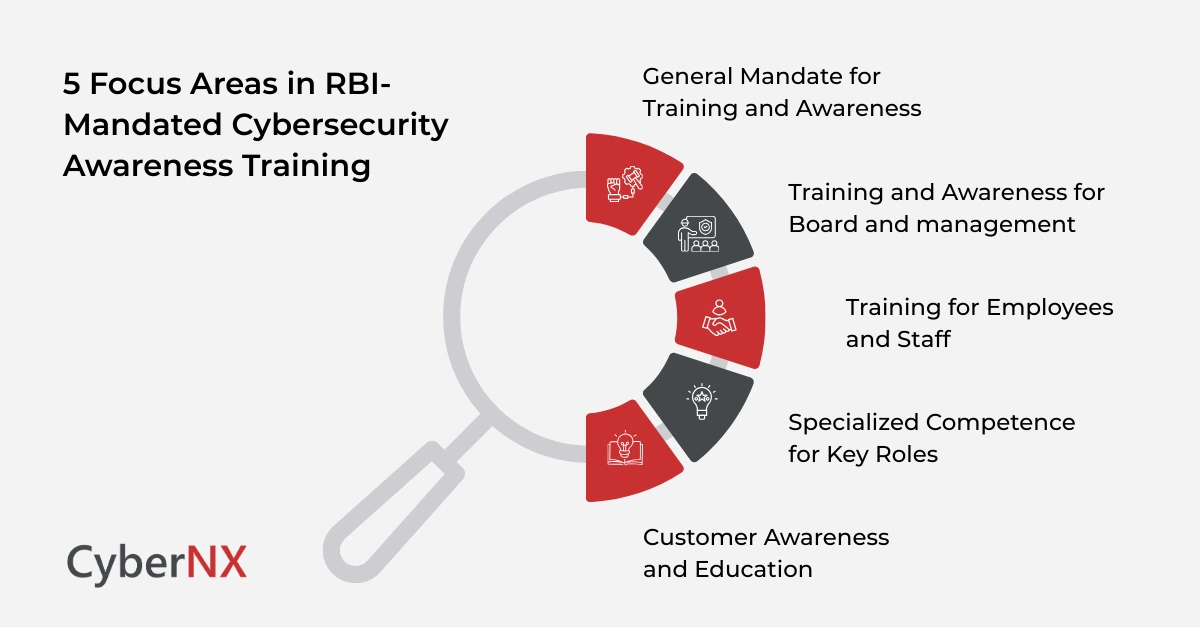In the financial sector, the human element remains a critical vulnerability. In this context, RBI mandates every regulated organisation to deliver cybersecurity awareness training under RBI IT framework to all levels of staff, management and board.
The purpose is simple: common threats – phishing, social engineering, lapses in vendor security – are preventable when awareness is high. But many institutions struggle to move from one-off training to sustained culture change.
We’ve worked with banks and non-bank Payment System Operators (PSOs) and seen how structured training under the RBI IT framework transforms risk posture. In this blog, we unpack the mandate and offer practical implementation guidance and show how to make this training more than a tick-box exercise.
The mandate under the RBI IT framework
First, let’s clarify what cybersecurity awareness training under RBI IT framework covers.
1. General mandate for training and awareness
The RBI’s revised directions (the Master Direction on Information Technology Governance, Risk, Controls and Assurance Practices, 2023) require regulated entities (REs) to establish processes for IT risk management and to create a culture of IT risk awareness and cyber hygiene practices.
For example, senior management and the IT Steering Committee must set up awareness-initiatives and ensure “adequate skilled resources, training and culture” form part of the cyber risk management architecture.
In the earlier framework, the Cyber Security Framework in Banks (2016) emphasised that “managing cyber risk requires the commitment of the entire organisation … a high level of awareness among staff at all levels”. It also states that the Board and Top Management need to be brought up to speed and that awareness/training programmes are required across roles.
2. Training and awareness for Board and management
The guidance specifically mandates that the Board of Directors and Top Management should have a fair degree of awareness about cyber threats and evolving best practices. In practical terms: Board-level training on IT risk / cyber‐security risk for all members at least once a year.
Furthermore, the IT Strategy Committee (ITSC) must have technically competent members and the structure must allow for awareness-campaigns for senior management.
This is critical because awareness at the top helps ensure the training at other levels receives the priority and funding it needs.
3. Training for employees and staff
The frameworks specify that REs must:
- Define and communicate security policy/policies to users, vendors and partners; educate them about cybersecurity risks and protection measures.
- Conduct targeted awareness/training for key personnel: operations staff, security-admin, management roles.
- Make cybersecurity awareness programmes mandatory for new recruits.
- Conduct web-based quizzes / training for lower, middle & upper management each year. Periodically evaluate awareness level.
- For non-bank PSOs, periodic repeated training/awareness programmes and periodic evaluation of awareness are mandated. (As part of the wider REs requirement)
4. Specialized competence for key roles
The RBI doesn’t stop at generic awareness. It requires specialised competence and training for specific roles:
- ITSC Chairperson: minimum 7 years of experience in managing information systems/technology/cybersecurity initiatives.
- ITSC Members: technically competent (understand/evaluate information systems and IT/cyber risks).
- CISO: must have requisite technical background; his office must be adequately staffed with people with necessary technical expertise.
- The SOC: Level 1, 2, 3 monitoring staff must have progressively deeper training (from vendor/product certification at Level 1 to malware reverse-engineering/forensics at Level 3).
- VA/PT: Vulnerability Assessment & Penetration Testing must be carried out by appropriately trained and independent information security experts/auditors. These requirements focus training investments where they matter most and ensure awareness is complemented by competence.
5. Customer awareness and education
Finally, the frameworks require REs to educate customers (and in some cases the public) about cybersecurity risks. For example:
- Strong programmes focussed on customer awareness to reduce phishing.
- Customers should be encouraged to report phishing mails/sites; educate on the risk of sharing login credentials/passwords with third parties. Scribd These are often overlooked but are key to reducing the “weak link” of the external human factor.
Why awareness training matters for regulated entities
Awareness training is more than compliance. Here’s why it matters from a strategic and operational viewpoint:
1. Break down siloed risk culture
Even with strong technical controls, human behaviour can undermine them: clicking phishing links, weak passwords, vendors not following good practices. The training helps shift behaviour.
When the Board and senior management understand their role, awareness cascades down-wards and budgets/support go up.
2. Meet regulatory oversight and supervisory expectations
Failure to demonstrate training programmes, evaluations of awareness levels and reporting may attract regulatory scrutiny from RBI. The frameworks make it clear that training is part of the IT risk management obligation.
3. Build a resilient cybersecurity-culture
Training improves detection of suspicious behaviour (by employees and customers), faster incident reporting, stronger vendor/third-party hygiene and overall cyber-resilience.
It also supports the specialised competence requirements – if the general workforce is aware, specialised teams can focus on advanced work rather than basic hygiene.
4. Reduce risk-adjusted cost
The cost of a breach for a bank or PSO is huge: reputational loss, regulatory penalties, remediation costs. Effective awareness training reduces the likelihood and impact of incidents, thus reducing total risk-adjusted cost of ownership of the security programme.
5. Support business transformation
Many financial institutions are undergoing digital transformation, new channels, open banking, fintech partnerships. Training ensures the human component keeps pace with these changes and does not become the weakest link.
How to implement an effective training programme under the RBI IT framework
Here’s a step-by-step outline we’ve used with clients like those we serve at CyberNX to implement training programmes that meet RBI requirements and drive actual behaviour change.
Step 1: Governance & mandate
- Secure Board/Senior Management buy-in. Show how training links to regulatory mandate and business risk.
- Define responsibilities: Information Security Committee (ISC) approves and monitors training and awareness initiatives.
- Map roles to training needs: Board & Top Management, Senior Management, Middle/Lower Management, Operations, IT security, Vendors, Customers.
Step 2: Assess current state
- Conduct a gap assessment: what training has been done, what awareness levels exist, what feedback/metrics exist.
- Evaluate audience segments and role-specific needs.
- Define KPI/metrics – e.g., % of employees trained, awareness quiz results, phishing click-rate, vendor training completion.
Step 3: Design training and awareness content
- For Board & Senior Management: sessions on cyber-risk landscape, strategic oversight, role of Board in IT governance.
- For employees: modules on phishing, credential hygiene, vendor/third-party risks, incident reporting.
- For specialised roles: deeper training for SOC analysts, VA/PT teams, audit, etc.
- For customers and vendors: awareness campaigns, email/sms communications, vendor portals.
Step 4: Delivery and cadence
- Mandatory onboarding training for new recruits.
- Annual refresher training for all employees including web-based quizzes.
- Targeted training for key personnel (executive, operations, security roles).
- Board training at least once a year.
- Vendor training/awareness every period as per third-party risk appetite.
- For non-bank PSOs: periodic repeated awareness programmes and periodic evaluation of awareness. Make use of e-learning platforms, simulations (e.g., phishing), workshops, webinars.
Step 5: Measurement and review
- Evaluate awareness level periodically via quizzes, phishing simulation results, metrics defined.
- Report to ISC/Board on training completion rates and awareness effectiveness.
- Use incidents and near-misses to refine content.
- Review training annually for relevance to evolving threats, regulatory changes and business model changes.
Step 6: Continuous improvement
- Adapt training content based on emerging threats (ransomware, supply-chain attacks, fintech vulnerabilities).
- Integrate training with vendor risk management, customer education programmes.
- Consider behavioural insights: how people learn, how to boost engagement (gamification, micro-learning).
- Ensure training for specialised roles evolves (for example, SOC Level 2/3 staff get advanced forensics, malware reverse engineering).
Key benefits for your organisation
When you implement an awareness training programme aligned to the RBI IT framework, you realise several concrete benefits:
- Improved risk culture throughout the organisation: instead of compliance-only mindset, a proactive cyber-aware workforce.
- Stronger Board oversight and senior management engagement in cyber risk: better strategic alignment of IT and business.
- Reduced incidence of security breaches triggered by human error or weak vendor/partner practices.
- Better vendor/third-party security hygiene via training and awareness programmes.
- Enhanced customer trust and reduced fraud/leakage from your customer base due to stronger customer awareness campaigns.
- Demonstrable compliance with RBI expectations, reducing regulatory risk and associated cost.
Conclusion
Training and awareness are non-negotiable under the RBI IT framework. From Board to frontline staff, from vendors to customers, more than ever you must ensure that cybersecurity awareness training under RBI IT framework is built into your operational fabric.
At CyberNX, our RBI Master Directions Compliance team have designed training programmes for businesses across India. It helps in meeting regulations and shift behaviour to strengthen your security posture. If you’re ready to transform one-time training into a dynamic, risk-aware culture, let’s talk about how we can help.
You can also reach out to us in case you need a detailed assessment of your awareness programme and how it aligns with the RBI IT framework.
Cybersecurity awareness training under RBI IT Framework FAQs
How often should Board members undergo cybersecurity awareness training under the RBI IT framework?
The guidelines suggest Board members may be provided with training programmes on IT Risk / Cyber-security Risk and evolving best practices so that all Board members are covered at least once a year.
Can vendor staff be exempted from the awareness training obligations?
No. The training and awareness requirements extend to vendors and partners. The frameworks require communicating security policies to vendors and educating them about cyber-risks and protection measures.
What metrics should an organisation track to measure training effectiveness?
Example metrics include: coverage of anti-malware software update rate, patch latency, extent of user awareness training, click-rate on simulated phishing campaigns, quiz pass-rates, periodic evaluation of awareness level.
Does the RBI framework require special training for SOC/forensics staff?
Yes. The frameworks specify that SOC Level 1, 2, 3 staff need progressively deeper expertise: Level 1 requires vendor/product certification; Level 2 requires highly trained staff in specific areas; Level 3 (SOC analysts) require profound knowledge of security, forensics and malware reverse-engineering.






